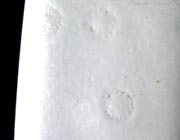
The Cause of Starring
We are using a Wrinkle Dark Gray powder and we keep getting little "star bursts" all over the product. We also spray a wrinkle black, but it is not so pronounced. If we use our smooth powders we have no problem. We have cleaned the booth filters and hopper with no results. The star burst still shows up. Can you help?There are several questions that need to be answered first. Are these star bursts visible before the powder is cured? Is the wrinkle created chemically in the curing process or does the powder have some kind of filler that mechanically creates the wrinkle? Are you getting what the industry calls a "fish eye"? Have you taken a sample of the material and sprayed it in a different environment to see if the star burst problem continues? Answers to these questions will provide more information helping to answer your question. One thing that we know is star burst defects can be created from excessive voltage, inadequate grounding on the part, and chemical makeup of the powder or foreign material. Location of the gun to the part (target distance) affects how quickly the star burst effect (or back-ionization) will occur. The closer a gun gets to a part, the faster back-ionization occurs.
Back-ionization occurs when charged powder particles cannot find a ground point on the surface of the part and consequently build unevenly onto other particles on the part surface. As the powder builds, it insulates the grounded surface, resulting in a rough surface texture (in the uncured state). Typically called "starring," the uneven coverage of the powder will still cure, but produce an "orange peel" look. For most decorative appearances, the orange peel appearance is undesirable. Beside heavy film builds, excessively "hot" or conductive powders also cause back-ionization.
To avoid back-ionization try the following:
- Lower the voltage setting, but be aware that reduced voltage may lead to unacceptable penetration and/or coverage.
- Optimize the gun's distance to the part and attempt to maintain that distance. This often relates to the hanger design. Make sure the hangers are consistent and repeatable. Bent hangers or swinging parts change the target distance. Typically, having the gun too close to the part contributes to the problem.
- Use a grounding ring or some form of ion collector as a ground source to reduce the surface effect. These devices are made by the manufacturer specifically for the applicator type and are installed behind the gun's electrode tip. The purpose is to capture unused ions from the charging process that may disrupt the surface coating by bombarding the already deposited powder.
If you try these tips and still see no improvement, you should check the part-to-ground resistance. This reading should be less than 1 megaohm of resistance to ground and the closer this number gets to zero, the better the ground. You also were correct in cleaning out the system in an effort to eliminate this as a variable. Finally, you should contact your powder material supplier and/or application equipment manufacturer to inquire how they can help.



